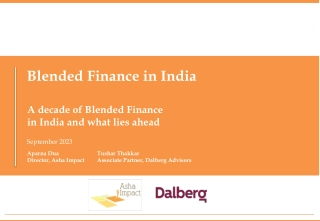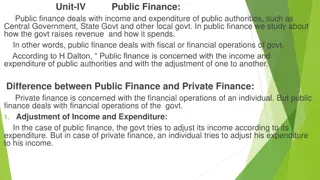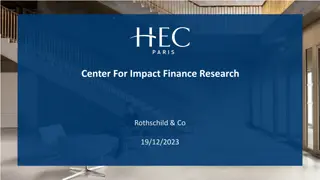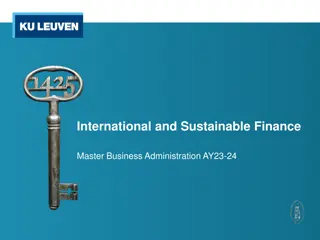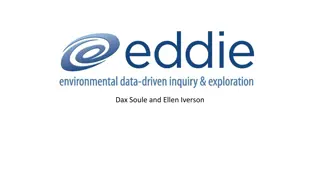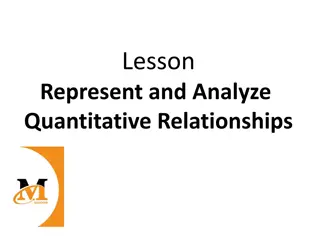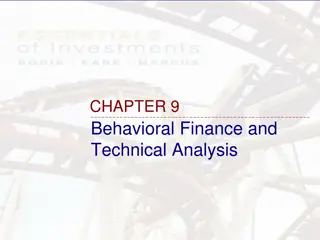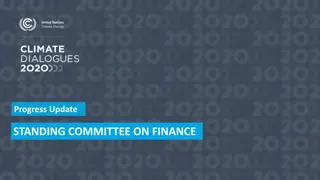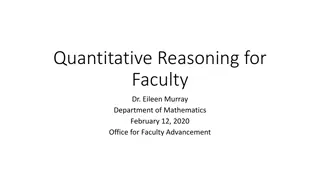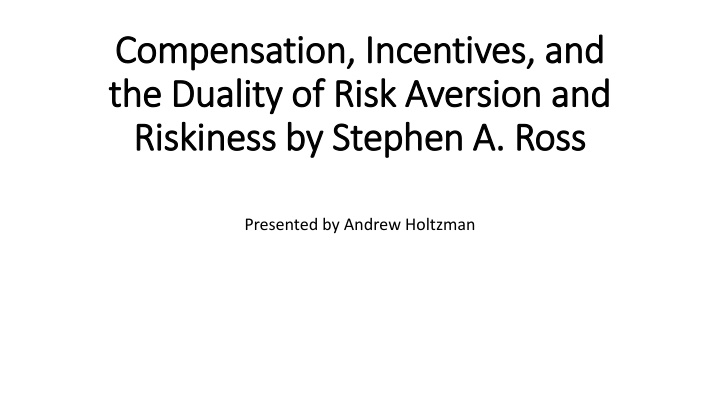
Executive Compensation and Risk Aversion
Explore the complex relationship between executive compensation, risk aversion, and incentives through the insightful analysis presented by Stephen A. Ross. Discover how incentive structures impact risk preferences and delve into the duality of risk in compensation schemes.
Download Presentation

Please find below an Image/Link to download the presentation.
The content on the website is provided AS IS for your information and personal use only. It may not be sold, licensed, or shared on other websites without obtaining consent from the author. If you encounter any issues during the download, it is possible that the publisher has removed the file from their server.
You are allowed to download the files provided on this website for personal or commercial use, subject to the condition that they are used lawfully. All files are the property of their respective owners.
The content on the website is provided AS IS for your information and personal use only. It may not be sold, licensed, or shared on other websites without obtaining consent from the author.
E N D
Presentation Transcript
Compensation, Incentives, and Compensation, Incentives, and the Duality of Risk Aversion and the Duality of Risk Aversion and Riskiness by Stephen A. Ross Riskiness by Stephen A. Ross Presented by Andrew Holtzman
Disclaimer This work is not my own and I do not claim to have any contributions. This is merely my presentation of the paper authored by Stephen A. Ross on executive compensation. I hope you enjoy and please feel free to fact check my presentation with the original paper.
Abstract The common folklore that giving options to agents will make them more willing to take risks is false. In fact, no incentive schedule will make all expected utility maximizers more or less risk averse. This paper finds simple, intuitive, necessary and sufficient conditions under which incentive schedules make agents more or less risk averse. The paper uses these to examine the incentive effects of some common structures such as puts and calls, and it briefly explores the duality between a fee schedule that makes an agent more or less risk averse, and gambles that increase or decrease risk.
Overview of Paper Section I: Examine two scenarios impact on risk aversion, when the fee schedule is a call option and when it is equivalent to a bond position with a short put option. Section II: General theory for necessary and sufficient conditions in making an agent more or less risk averse. Section III: How to modify a fee schedule to make an individual less risk averse. Section IV: Break down the fee schedule into three separate pieces: the convexity effect, the translation effect, and the magnification effect Section V: explores the duality between a fee schedule that concavifies a utility function and a schedule that makes the underlying payoff riskier
Overview Executive pay increases have far outpaced corporate profits, economic growth and the average compensation of all workers Source: Economic Policy Institute, 2011
Overview Between 1980 and 2004, Executive pay rose 8.5% per year while corporate profits grew 2.9%, and per capita income grew 3.1% By 2006 CEOs made 400x more than their average workers In 1965 CEOs made 20x more than their average workers 10.3% of corporate income was used to compensate CEOs in 2003 Compare this to 4.8% in 1995 Half of a trillion dollars given to top five earning executives at each of the 1500 largest companies in the US from 1994-2004 S&P 500 CEOS average pay was $9.6m in 2011
Section I: Option Fee Schedule Consider an executive pay package consisting of a fee and stock options (not fungible and must be held to maturity). Options are advantageous over stock for tax purposes, and since they must be held to maturity, the executive cannot simply sell them after increasing the volatility of the underlying (higher volatility means a more valuable option). If a convex fee schedule makes agents less risk averse it should hold under: X is total number of shares, a is total exercise price of options F(x) = max{x a, 0}
Section I: Option Fee Schedule If the agent s utility function is monotone and concave, it is given by: U(f(x)) = U(max{x a, 0}) = U(x a), x >= a, and = U(0), x <= a What does this actually mean? For x <= a the utility function is fixed at U(0) For x >= a it rises as the original utility function For x > a the result depends on whether U(x a) is less risk averse than U(x), so it depends on whether x has increasing or decreasing risk aversion
Section I If a > 0 and U has decreasing risk aversion, then U(x a) will be more risk averse than U(x) That said, the value of a call option is an increasing function of the volatility of the underlying, but derived utility is not always less risk averse than U(x) This presents a paradox that can be resolved by two effects: the convexity effect and translation effect Convexity of call option schedule makes risky bets more desirable, but this also shifts the domain of an agent s utility function
Section I In plain English let s break this down A division manager will likely have a year end bonus that is tied to some accounting metric as a performance measure with a floor and a ceiling If the metric is currently close to the ceiling, the manager may manipulate things so that the metric hits the ceiling, rather than being in range of the floor and ceiling and proportional to the performance indicator It is unclear that the manager would be more risk averse toward earnings and be unwilling to risk falling below the ceiling
Section I Consider a junior bond. If the payout option is proportional to the performance indicator, then volatility would decrease the value of the bond near its principal payout i.e. value would decline with increases in volatility Illustrated by the following where b is a fixed fee and a is the exercise price of a put option F(x) = b max{a x, 0} = min{b a + x, b} In the example above, x represents the performance indicator, b is the maximum payout, and a is the level where the payout maxes out U(f(x)) = U(min{b a + x, b}) = U(b a +x), x < a, and U(b) >= a
Section I Despite a concave fee schedule, whether U(f(x)) is more risk averse than U(x) depends on the region of the domain U moves to (more or less risk averse) Consider when b a > 0, the domain is shifted to the right If U has increasing risk aversion, then it will be more risk averse than U(x), changing the increase in risk aversion at x = a (exercise price) If U has decreasing risk aversion, x > b a, U(f(x)) is locally less risk averse than U(x) despite f s concavity
Section II: General Theory The compensation schedule, f, makes a utility function, U, concave if the derived utility of the schedule is more risk averse than the original. On the contrary, if the opposite is true f would cause U to be convex. This definition is used to characterize fee schedules that increase or decrease risk aversion: U(f) = G(U) A fee schedule causes a utility function to be concave if and only if there exists a monotone concave function G, such that U(f) = G(U)
Section II: General Theory Definition 2: A fee schedule, f, convexifies a utility function, if and only if there exists a monotone convex function, G, such that, U(f) = G(U) Via a long proof we can rearrange to G (u)(U )2= U (f)f [A + f /f A(f)f ], where A is the coefficient of absolute risk aversion Which leads us to Theorem 1: the compensation schedule, f, concavifies (convexifies) U if and only if f /f = <=(>=) A(f)f A Corollary 1: The compensation schedule, f, concavifies (convexifies) U for all U only if f is concave (convex) Corollary 2: There is no compensation schedule that concavifies (convexifies) all U
Section II: General Theory Note DARA are utility functions with decreasing absolute risk aversion, and IARA are utility functions with increasing absolute risk aversion Theorem 2: The compensation schedule, f, concavifies U in DARA if and only if f is concave, f <= x, and f >=1, and it convexifies all U in DARA if and only if f is convex, f >= x, and f <= 1. The compensation schedule f concavifies all U in IARA if and only if f is concave, f >= x, and f >= 1, and f convexifies all U in IARA if and only if f is convex, f <= x, and f <= 1
Section II: General Theory Theorem 3: If f in A(dc) or f in A(ic) implies that f concavifies U, the U is DARA or IARA, respectively. If f in A(dx) or f in A(ix) implies that f convexifies U, then U is DARA or IARA, respectively.
Section III Theorems 2 and 3 need to be modified to fit a real world setting. As they stand, they are the comparison between an agent receiving an entire payoff, x, and receiving some fixed schedule f(x) Consider when f(x) > x. This would require the executive be paid more than opportunity cost of the company We can alter the schedule so that f and g satisfy some budget constraint and H is a transformation such that U(g(f(x))) = H(U(f(x))) Let z = f(x) U(g(z)) = H(U(z))
Section III Corollary 3: Altering an existing fee schedule, f(*), to g(f(*)), concavifies the derived utility function for all U in DARA if and only if g is concave, g <= x, and g >= 1, and it convexifies it for all U in DARA if and only if g is convex, g >= x, and g <= 1. The alteration g concavifies the derived utility function for all U in IARA if and only if g is concave, g >= x, and g >= 1, and g convexifies it for all U in IARA if and only if g is convex, g <= x, and g <= 1
Section III Corollary 4: Let Ag and Af denote the coefficients of absolute risk aversion for g and f, respectively. Adding g to an existing fee schedule, f, concavifies the derived utility function for all U in DARA if and only if Af <= Ag, g <= 0, and g >=0, and it convexifies Af <= Ag, g >= 0, and g <= 0. The alteration g concavifies the derived utility function for all U in IARA if and only if Af <= Ag, g >= 0, and g >= 0 and g convexifies it for all U in IARA if and only if Af <= Ag, g <= 0, and g <= 0.
Section III Example of Corollary 4: A CEO currently is salaried at $1m and has existing ATM call option grants on one million shares of stock with both a current price and exercise price of $20 per share. The board wants to raise to pay because competitors are doing so, but the shareholders are not supportive of this. The CEO s annual assessment also shows she is too conservative. The board decides to give her 1m ATM grant calls. This will meet market sentiments and encourage risk right? If the CEO displays characteristics of Corollary 4 i.e. DARA, then the impact of the option grant is ambiguous and may cause more conservative behavior
Section III What else could the board do? Transform the current option grant into a collar option by granting puts on 1m shares with exercise price of $10 per share. This means the manager would be protected if the share price dropped below $10, but could gain from stock increases. Under Corollary 4, the manager would be more willing to take risk.
Section IV What is the impact on a CEO from a call option grant? First, they already have call options, so more will not likely translate to more risk taking Second, more options will increase the delta of the total compensation package, so an already risk averse CEO will be even more risk averse The intuition as follows: Derived Utility fcn: V(x) = U(f(x)) Translation Effect: A(f) A(x) Magnification Effect: A(f)[f 1] Convexity Effect: Af(x)
Section IV Av(x) A(x) = Translation Effect + Magnification Effect + Convexity Effect Whether the derived utility function is more or less risk averse than the original depends on whether the sum of the three effects are is positive or negative These three are locally independent In order to understand the these effects, let us consider an example with a utility function having a constant absolute risk aversion, the translation effect disappears since the utility function has the same risk aversion at all points in the domain
Section IV The magnification effect only depends on whether or not the fee schedule is increasing faster or slower than x Faster means a positive effect Slower means a negative effect Regarding the magnification effect, if f (x) > 1, then a small gamble at x with a standard deviation of sigma will be magnified to sigma*f (x) Raising the risk of the gamble and lowering the agent s willingness to take it on When there is a constant absolute risk aversion utility function, while there is no translation effect, the magnification effect is sufficient to offset the convexity effect
Section IV This is because if f >= 0 is sufficiently less than 1, then the magnification effect can be negative enough to exceed the convexity effect This will result in the agent becoming more risk seeking even with a concave fee schedule. See P.14 of paper for full mathematical example and proof
Section IV These effects can take any sign and the resulting derived utility function can be more or less risk averse than the original function Let us reconsider the example of the CEO from a few slides back. Remember that a put option may convexify a schedule for an agent with decreasing absolute risk aversion A put option is nonnegative, declining, and convex. The nonnegative aspect adds to wealth and makes the agent less risk averse i.e. translation effect, it is convex from the convexity effect, and it has a negative slope so its addition to payoff will lower the magnification effect
Section IV Adding call options to the payoff has a positive convexity effect, positive translation effect, and negative magnification effect Put simply, when the put option is ITM the agent will see even money gambles as less risky, but with call options the gambles appear riskier and lower the agent s incentive to accept them Carpenter (2000) if a portfolio manager has a DARA or a CARA utility function and receives call options as compensation, the manager seeks to reduce the volatility of the managed portfolio if the number of call options was increased
Section IV This suggests that the utility function had been concavified by the addition of call options From Corollary 4 we know that adding call options to a fee schedule will not concavify all DARA utility functions and we must overcome the local convexity effect For CARA functions there is no translation effect, so the magnification effect is larger than the convexity effect in this scenario
Section V Since a fee schedule that concavifies a utility function makes the agent more risk averse, but does NOT make the underlying payoff riskier Executives that have a cap on their option compensation, do NOT have the same incentives as executives at riskier firms with no cap A random variable is riskier than another if and only if it is weakly inferior for all monotone, concave utility functions i.e. E[U(y)] <= E[U(x)] If a function existed then, by duality, it would make any agent more risk averse. Corollary 2 showed that no such schedule exists
Section V Definition 4: A random payoff y is said to be S-riskier by c (a constant) than a payoff x if and only if x is rejected for some U in S, and, whenever x is rejected by U in S, U prefers c to y, that is E[U(x)] <= U(0) => E[U(y)] <= U(c) Definition 5: A function f is a risk-inducing transform if for any random x, f(x) is S riskier by f(0) than x Theorem 4: A function f is an S risk-inducing transform if and only if it concavifies U in S See page 16 for example and proof
Section V Theorem 5: The compensation schedule, f, is DARA risk inducing if and only if f is concave, f <= x, and f >= 1, and it is IARA risk inducing if and only if f is concave, f >= x, and f >= 1
Conclusion There is not sufficient evidence of the classic idea that a convex fee schedule makes an agent less risk averse and that a concave one induces greater risk aversion They are necessary conditions for the result to hold for utility functions, but not sufficient The impact of the fee schedule on the agent s attitudes towards risk depends not only on the convexity, but also on how it translates the domain of the utility function to a more or less risk averse portions and to the extent to which it magnifies or contracts any gamble at the margin
Conclusion People often argue that call options make executives more willing to take risk, but this depends on the wealth effect of the option Increasing the wealth of the executive may move them into a more or less-risk averse portions of the utility function Options can have a magnification effect that could lead to more risk aversion
My Opinion An early footnote in the paper for Figure 1 states that they assume the individual is not allowed to make use of a market for fair gambles or a complete market to concavify the utility function I would argue the executive would in fact have access to a complete market because the options are grants (i.e. there is no transaction cost for the agent) and she has access to insider and public information eliminating asymmetry This would create a complete market and thus complicate the model
My Opinion I agree with their assertions about adding a put option or collar to the mix Call options seem to do less to encourage risk taking and more to encourage stability, while put options would allow the agent to gain from the upside while protecting against the downside if she fails

